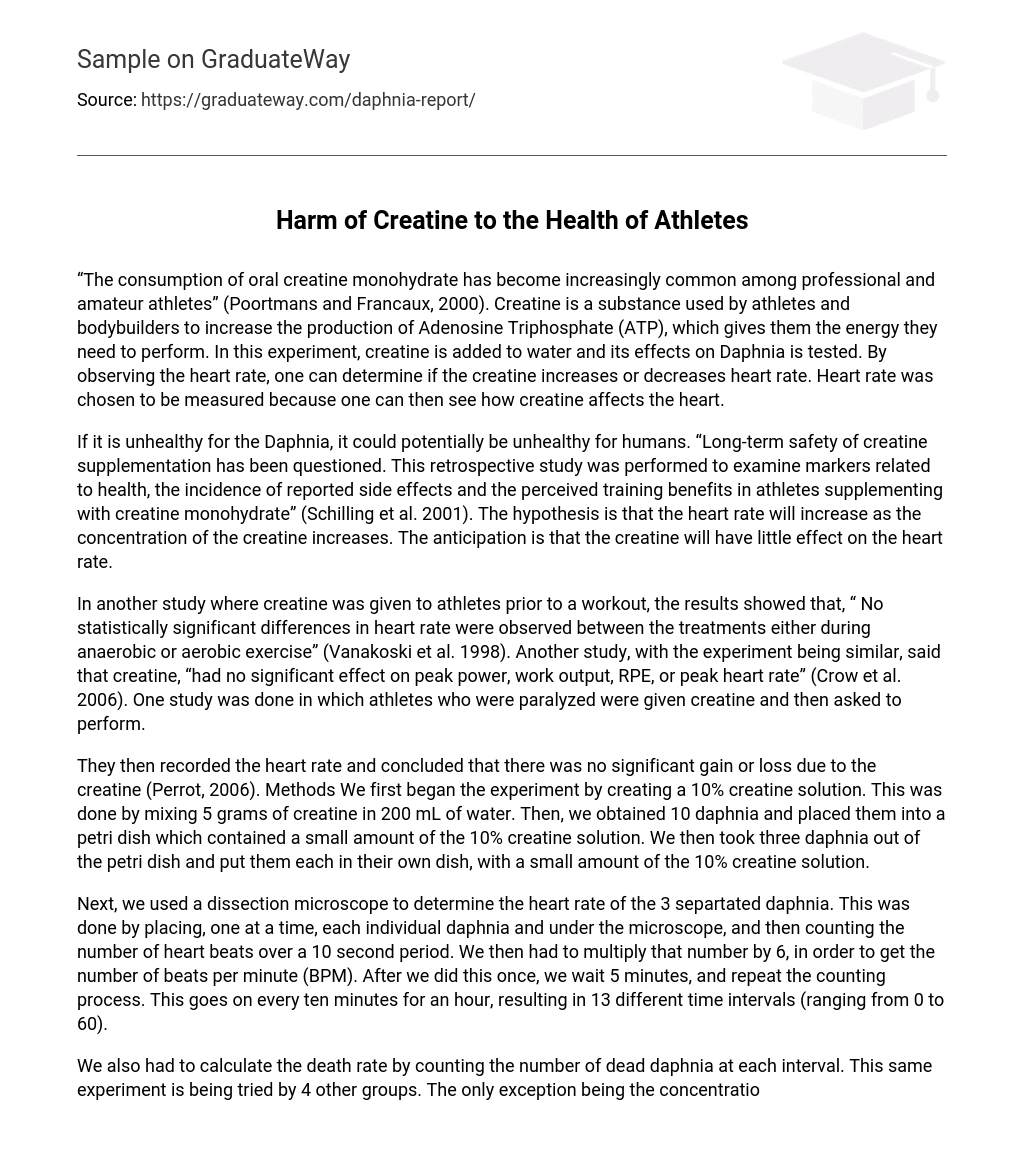According to Poortmans and Francaux (2000), there has been an increase in the use of oral creatine monohydrate among professional and amateur athletes. Creatine is a substance that athletes and bodybuilders use to improve the production of Adenosine Triphosphate (ATP), which gives them the energy needed for performance. This study aims to investigate the impact of creatine on Daphnia by adding it to water, specifically focusing on any changes in heart rate as a measure of how creatine affects the heart.
Should the Daphnia encounter any negative effects, it could also have harmful ramifications for humans. Schilling et al. (2001) performed a study to evaluate the long-term safety of creatine supplementation and its possible adverse effects on athletes. The research analyzed different measures of health and training advantages linked to consuming creatine monohydrate supplements. The hypothesis proposes that heightened levels of creatine will result in an increased heart rate, although the expected effect on heart rate is anticipated to be slight.
A study conducted by Vanakoski et al. (1998) found that there were no significant differences in heart rate during anaerobic or aerobic exercise when athletes took creatine before their workout. Similarly, Crow et al.’s (2006) research also showed that creatine had no major impact on peak power, work output, rating of perceived exertion (RPE), or peak heart rate. Additionally, another study involved paralyzed athletes who received creatine and participated in physical tasks.
Perrot (2006) found that there was no significant change in heart rate due to creatine. The experiment began with the preparation of a 10% creatine solution, involving the mixing of 5 grams of creatine with 200 mL of water. Then, 10 daphnia were placed in a petri dish containing a small amount of the 10% creatine solution. Afterward, three of the daphnia were transferred to individual dishes, each filled with a small amount of the same 10% creatine solution.
Next, we utilized a dissection microscope to determine the heart rate of the three separated daphnia. We achieved this by placing each individual daphnia one by one under the microscope and counting the heart beats during a 10-second span. Afterward, we multiplied that count by 6 to obtain the beats per minute (BPM). Following this, we waited for 5 minutes and repeated the counting procedure. This cycle was repeated every ten minutes for an hour, resulting in a total of 13 time intervals ranging from 0 to 60.
The number of dead daphnia at each interval was used to calculate the death rate. This experiment involved four groups, who varied only in the concentration of creatine (0%, 2%, 5%, and 20%). The concentration of creatine served as the control variable, while the heart rate and death rate of the daphnia were considered independent variables. To ensure all necessary information was obtained, data was exchanged with each group at the end of the experiment. Table 1 displays a vertical column for the heart rate of the daphnia and a horizontal column for the corresponding time.
The initial heart rate of the daphnia increased within the first 10 minutes but later either stabilized or decreased. It is important to note that the final heart rate differed between the daphnia in the 0% and 20% creatine groups. The average heart rate was higher in the daphnia without creatine compared to those with 20%. The heart rates followed an ascending pattern, starting with the highest in the 0% group and gradually decreasing in the 2%, 5%, 10%, and finally 20% groups. Table 2 shows the number of dead daphnia at different times. Interestingly, only six daphnia died across all experiments, and all six deaths occurred within one concentration group.
If you compare the graphs of heart rate and death rate for the 2% concentration, you will notice a notable decline in heart rate as the death rate rises. The findings suggest that the creatine concentration had minimal influence on the daphnia’s heart rate. This is evident from the irregular heartbeats observed at each time interval. Every daphnia exhibited an initial increase in heart rate, followed by a period of stability, and then some experienced a decrease. The data contradicts my hypothesis as there was no impact of creatine concentration on the heart rate.
Confirming previous research mentioned in the introduction, my findings are consistent with those of other scientists who have conducted similar experiments. The experiment demonstrated that creatine does not affect heart rate. Thus, it was determined that heart rate remains unaffected by creatine and individuals who use this substance may even experience a gradual decrease in their heart rate compared to non-users. Consequently, this study proposes further exploration into the potential long-term impacts of creatine on heart rate.
The experiment showed that the use of creatine resulted in a gradual decrease in heart rate. The following sources provide relevant information on this topic:
– Crowe, M. J., A. Leicht, W. Spinks. 2006. Physiological and cognitive responses to caffeine during repeated, high-intensity exercise.
– Perret, C., G. Mueller, H. Knecht. 2006. Influence of creatine supplementation on 800m wheelchair performance: a pilot study.
– Poortmans, JR., M. Francaux. 2000.Adverse effects of creatine supplementation – Fact or fiction?.
Schilling, B. K., M. Stone, A. Utter, J. Kearney, M. Johnson, R. Coglianese, L. Smith, H. O’Bryant, A. Fry, M. Starks, R. Keith, M. Stone. Creatine supplementation and health variables: a retrospective study. Sports Medicine 3: 155-170.
Vanakoski, J., V. Kosunen, E. Meririnne, T. Seppala. 1998. Creatine and caffeine in anaerobic and aerobic exercise: effects on physical performance and pharmacokinetic considerations.International Journal of Clinical Pharmacology and Therapeutics 5: 258-262.





